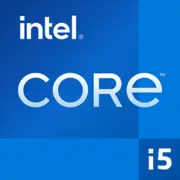Intel Core i5-12600

Intel Core i5-12600: Comprehensive Review of the 2025 Processor
Current Specifications, Assembly Tips, and Target Audience Analysis
1. Key Specifications: Architecture, Process Technology, Performance
Alder Lake Hybrid Architecture
The Intel Core i5-12600, released in late 2021, remains relevant in 2025 thanks to its balanced architecture. It features a hybrid structure composed of Performance cores (P-cores) and Efficient cores (E-cores). In this case, it includes 6 P-cores (12 threads) without E-cores, which differentiates it from the higher-end models in the series (such as the i5-12600K). P-cores are responsible for high performance in gaming and single-threaded tasks, while E-cores (which are absent here) typically optimize background processes.
Intel 7 Process Technology
Intel 7 technology (formerly known as 10nm Enhanced SuperFin) offers energy efficiency and high clock speeds. The base frequency is 3.3 GHz, with Turbo Boost up to 4.8 GHz. This allows the processor to compete with new AMD models in single-threaded scenarios.
Performance and Cache
With 18 MB of L3 cache, data processing is accelerated, and Geekbench 6 results (2364 — Single-Core, 9780 — Multi-Core) confirm its strength in rendering, gaming, and multitasking. For comparison: the Ryzen 5 7600 scores approximately ~2400/10500 but costs 10-15% more (around $220 vs. $200 for the i5-12600).
Key Features
- Integrated UHD 770 Graphics: Suitable for office PCs or as a backup display output.
- PCIe 5.0 Support: Future-proofing for SSDs and graphics cards.
- Intel Thread Director Technologies: Optimizes workload distribution across cores in Windows 11.
2. Compatible Motherboards: Sockets and Chipsets
LGA 1700 Socket
The processor uses the LGA 1700 socket, compatible with the 600 and 700 series chipsets (H610, B660, H670, Z690, B760, Z790). However, there is no point in opting for the top-tier Z690/Z790 for the i5-12600 since they are designed for overclocking (which is not available here).
Optimal Chipsets
- B660/B760: The best choice for most users. Supports PCIe 5.0, DDR4/DDR5 (depending on the model), and 2-4 M.2 slots. Examples of motherboards:
- ASUS TUF Gaming B660-Plus WiFi (DDR4, $140);
- MSI PRO B760-P WiFi (DDR5, $160).
- H610: Budget option, but lacks PCIe 5.0 and has RAM limitations (up to 3200 MHz). Suitable for office builds.
Choosing Tips
- Ensure that the motherboard supports DDR4 or DDR5, as this affects RAM costs.
- For future upgrades, it's better to choose a model with PCIe 5.0 x16 for the graphics card.
3. Supported Memory: DDR4 vs DDR5
DDR4-3200: Budget Stability
Most motherboards for the i5-12600 support DDR4, allowing for savings. A 16 GB (2x8) DDR4-3200 kit costs about $50, and the performance difference in games compared to DDR5 is minimal (5-10% at 1080p resolution).
DDR5-4800: Future-Proofing
DDR5 is more expensive (16 GB — $80) but offers advantages in high-bandwidth tasks (video editing, 3D rendering). By 2025, DDR5 prices have decreased, making it more attractive for new builds.
Recommendation
For gaming and everyday tasks — DDR4. For professional tasks — DDR5, if the budget allows.
4. Power Supplies: Power Calculation
TDP 65W Doesn’t Mean 65W for the Entire System
While the processor consumes up to 65W, a margin is needed considering the graphics card and other components.
Configuration Examples
- Integrated Graphics: PSU of 400W (e.g., be quiet! Pure Power 11 400W, $60).
- Discrete Graphics Card (RTX 4060): 550-600W (Corsair CX550M, $70).
- High-Performance GPU (RTX 4070 Ti): 750W (Seasonic Focus GX-750, $120).
Criteria for Choosing
- 80+ Bronze certification or higher.
- Modular design for ease of assembly.
5. Pros and Cons
Strengths
- Energy Efficiency: 65W TDP vs. 105W for Ryzen 5 7600.
- Integrated Graphics: No separate GPU is needed for basic tasks.
- Price: Around $200 (new) compared to $220-250 for competitors.
Weaknesses
- No E-cores: Reduced efficiency in multi-threaded scenarios compared to the i5-12600K.
- Limited Overclocking: No multiplier support (only Auto Boost is available).
6. Use Case Scenarios
Gaming
Average FPS in games (1080p, High):
- Cyberpunk 2077: ~65 FPS (with RTX 3060);
- Fortnite: ~144 FPS (with RTX 4060).
Work Tasks
- Video editing in Premiere Pro: 4K video rendering in 12-15 minutes.
- Programming: Fast code compilation due to high IPC.
Multimedia
Streaming in OBS without lag (using NVENC or Quick Sync).
7. Comparison with Competitors
AMD Ryzen 5 7600
- Pros: Higher multi-threaded performance, supports DDR5-5200.
- Cons: More expensive, requires costly AM5 motherboards.
Intel Core i5-13400
- Pros: More E-cores (4), better Multi-Core performance.
- Cons: Price $230, requires LGA 1700 (compatible with the same motherboards).
Conclusion: The i5-12600 excels in budget builds but is less competitive in multi-threaded performance.
8. Practical Assembly Tips
Example Configuration for $800
- CPU: Intel Core i5-12600 ($200);
- Motherboard: MSI PRO B660M-A DDR4 ($130);
- RAM: 16 GB DDR4-3200 ($50);
- SSD: 1 TB NVMe (WD Blue SN580, $70);
- PSU: Corsair CX550M ($70);
- Case: Deepcool MATREXX 40 ($60).
Important Nuances
- Choose a cooler with TDP of 100W or higher (e.g., Deepcool AK400, $35).
- For gaming, add a graphics card like the RTX 4060 ($300).
9. Final Conclusion: Who is the i5-12600 Suitable For?
This processor is ideal for:
- Gamers building entry-level to mid-range PCs.
- Office users who prioritize reliability and quiet operation.
- Enthusiasts planning an upgrade in 2-3 years (thanks to PCIe 5.0).
Why this one?
The balance of price, performance, and energy efficiency makes the i5-12600 one of the best choices in 2025 for those not chasing high-end specifications but valuing stability and technological relevance.
Basic
CPU Specifications
Memory Specifications
GPU Specifications
Miscellaneous
Benchmarks
Compared to Other CPU
Share in social media
Or Link To Us
<a href="https://cputronic.com/cpu/intel-core-i5-12600" target="_blank">Intel Core i5-12600</a>